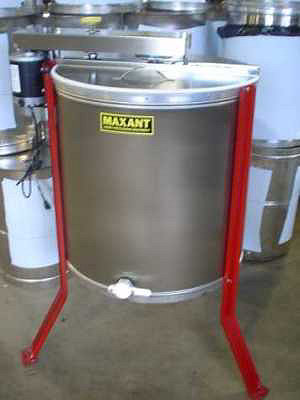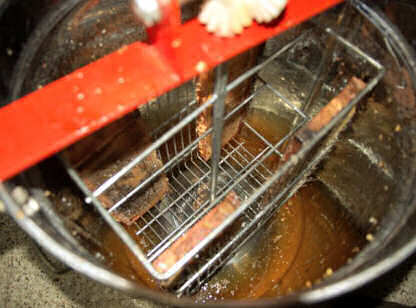Back to the Beepedia Index...
How do Beekeepers extract the Honey
Honey is a mixture of many substances. Its
composition depends upon the species of flowers from which the nectar is
collected. Nectar from the same species of flowers can also vary according to
the soil and climate. The honeybee adds enzymes from its hypopharyngeal gland
at the time of nectar collection and during transfer in the hive. The main
enzyme used is known as invertase, which breaks sugars down into glucose and fructose.
Water is evaporated from the nectar, usually down to about 17 or 18%.
An average honey will contain approximately
17% water, 38% glucose, 31% fructose, 1% sucrose, 9% other sugars and about 4%
organic acids and other substances.
The ratio of glucose to fructose is an
important determinant of how quickly honey will set or crystallise. Honeys with a
high glucose content set very rapidly (like oil seed rape honey), where high fructose
content will allow the honey to stay liquid for a long time (like acacia honey).
When the bees have reduced the moisture
content to a suitable level they will cap the honey with wax. Honey can be
eaten in this form, like honeycomb, and can be cut from the frames into small
portions and placed in clear plastic boxes. Extra thin unwired foundation is
normally provided in the frames. The bees can be induced to build comb in small
wooden framed squares known as “sections” which hold about a pound of honey and
command a high price.
Most honey is harvested by uncapping the
combs and extracting the honey by spinning the frames in an extractor. The
honey can then be filtered and run into bottles or tubs for bottling later. If
the honey crystallizes in the tubs it can be warmed until soft, stirred and
bottled as creamed honey, or warmed until clear and then bottled.

A honey extractor

Inside a honey extractor
Important forage crops in the southwest for
pollen or nectar include gorse, willow, blackthorn, cherry, pear, apple,
dandelion, sycamore, brassicas, horse chestnut, hawthorn, oil seed rape,
raspberry, blackberry, white clover, lime, rosebay willow-herb, bell heather,
ling heather, ivy as well as numerous other garden plants.
Back to the Beepedia Index...
|